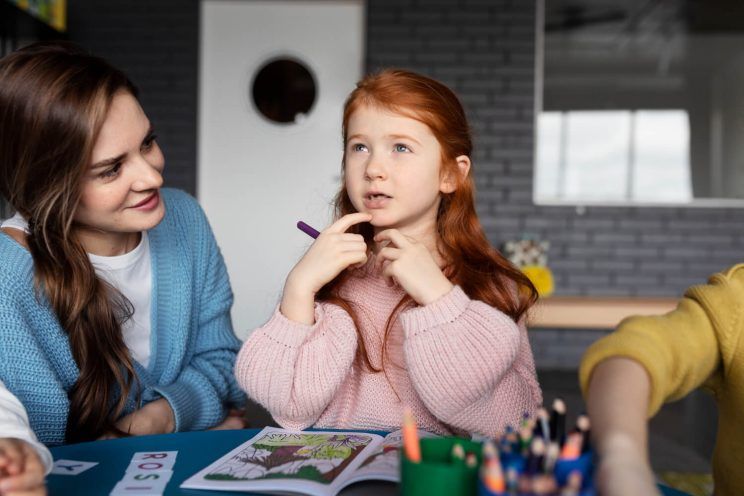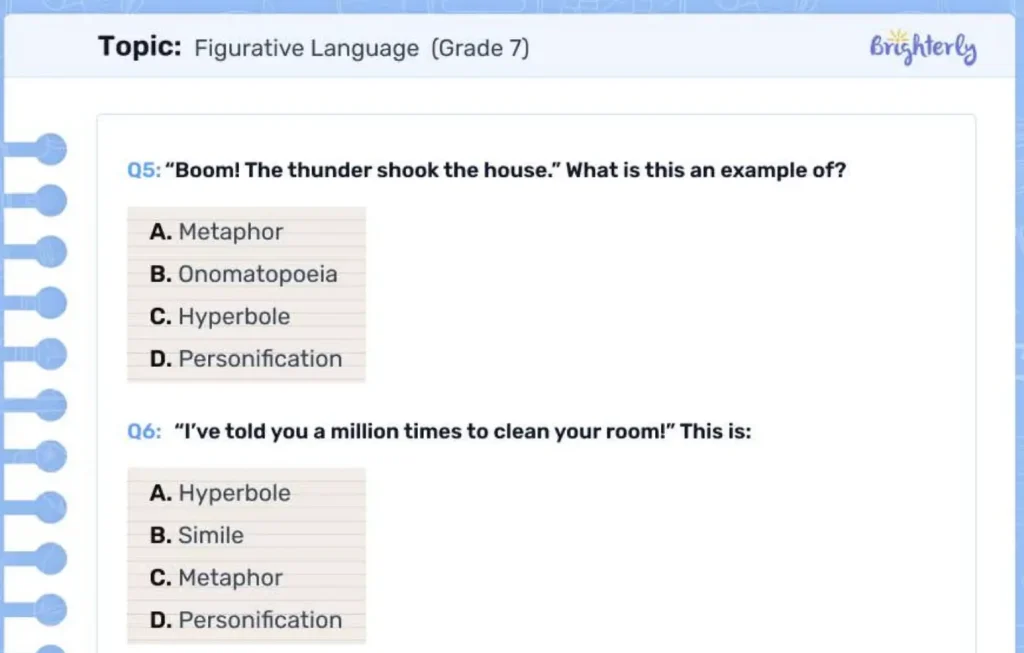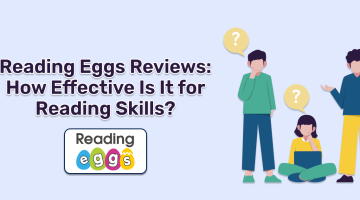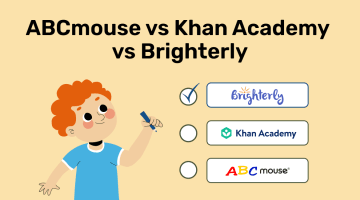Figurative Language Activities: Fun Ways to Play with Words
reviewed by Janice S. Armas
Updated on September 29, 2025
Fun figurative language activities with special words help kids learn about similes, metaphors, and idioms. These are ways to describe things that make stories more interesting. Instead of saying things plainly, kids use these expressions to make their stories lively. Doing figurative language practice, kids read better, write more creatively, and catch these special expressions in books, songs, and when talking with friends.
Key points
- Playing fun games and doing activities that use special ways of talking — like similes (“as brave as a lion”), metaphors (“the world is a stage”), and idioms (“it’s raining cats and dogs”) — helps kids get better at reading and writing.
- When kids practice these fun exercises regularly, they become better at understanding stories, coming up with their own creative ideas, and feeling more confident.
How to teach figurative language?
Teachers can introduce figurative language lessons using simple examples kids hear every day. Short activities for figurative language, like underlining figurative words, acting out phrases, or inventing examples, help students engage without feeling overwhelmed.
Ways to teach figurative language
- Start with what kids already hear. Phrases like “it’s raining cats and dogs” or “she’s a shining star” pop up all the time. Point them out and ask, “What do you think that really means?” or “Why do you think the writer said it that way?”
- Keep it simple. No need for long, heavy lesson. Short, easy activities work best — like underlining figurative words in a story, acting out a funny phrase, or inventing their own examples.
- Practice a little every day. A few minutes daily goes a lot further than one big lesson. Consistency helps kids spot figurative language naturally, almost without trying.
- Make it playful. Fun activities — like those on Brighterly’s reading worksheets — turn learning into a game. Kids get to play with words, test out new ideas, and get feedback right away.
- Connect it to real life. Once children see how figurative language shows up in songs, movies, or conversations with friends, they realize it’s everywhere. Understanding these “language tricks” soon feels natural — just another part of everyday life.
What are the 7 main types of figurative language?
- Simile
- Metaphor
- Personification
- Hyperbole
- Onomatopoeia
- Idioms
- Alliteration
Figurative language isn’t one trick — it’s a whole toolbox writers and speakers use to make words sparkle.
- Simile – Uses “like” or “as” to compare. Example: “She’s as bright as the sun.” Kids can try making similes about their friends, pets, or favorite foods.
- Metaphor – A stronger comparison where one thing is another. Example: “He’s a rock.” It pushes kids to see connections they don’t notice at first.
- Personification – Gives human qualities to objects. Example: “The flowers danced in the wind.” This helps kids imagine scenes more vividly.
- Hyperbole – Extreme exaggeration for effect. Example: “I’m so hungry I could eat a horse.” This is a great way for kids to be silly and creative with language, making fun figurative language activities more engaging.
- Onomatopoeia – Sound words like “boom,” “splash,” or “buzz.” Kids love spotting these in comics, songs, or picture books.
- Idioms – Phrases that mean something different from their literal words. Example: “Hit the hay.” Teaching idioms helps kids understand everyday conversations.
- Alliteration – Repeating the same starting sound. Example: “Sally sells seashells.” It’s playful and improves memory and pronunciation.
👉 Why it matters: A study by Cain and colleagues (2005) found that skilled comprehenders better understood idiomatic expressions compared to less skilled ones, highlighting the importance of figurative language comprehension in reading skills. It also supports creativity and narrative skills in both elementary and secondary students.
Figurative language activities for elementary students
Figurative language activities for middle school
- Song lyrics analysis
- Create your own expressions
- Figurative language scavenger hunt
- Figurative language project
Figurative language activities for high school
12 best figurative language activities
When it comes to teaching figurative language, some activities just stick better than others. The goal is to make learning hands-on, memorable, and fun, whether students are in elementary, middle, or high school. Here’s a list of the most effective practices I’ve seen work repeatedly — all adaptable depending on the grade level.
Figurative language activity #1: Using worksheets for practice
Worksheets don’t have to be boring — in fact, they can turn reading into a creative adventure! Using worksheets, students can learn to decode similes, metaphors, idioms, and other figurative expressions through fun passages and practice exercises. This structured approach not only improves reading comprehension but also boosts critical thinking and creative expression.
For example, Brighterly figurative language worksheets (7 grade) are designed to make learning engaging and interactive. It helps kids learn in an exciting way. They have different lessons for beginners and for older students in 7th grade. These activities teach children how to find and understand figures of speech, like metaphors and similes, in stories,poems, and everyday conversations. Whether your child is reading a poem, a story, or short texts, these worksheets help them become better at understanding and using expressive language. Older students, especially those in figurative language high school programs, can also benefit from these exercises.
Some key benefits of Brighterly worksheets
- It’s a free PDF that you can open on your computer or tablet, making it easy to use at home or in school.
- It has fun activities with answers included, so you can check your work and learn from mistakes right away.
- Kids can work on their own, helping them feel more confident.
- The activities follow special learning rules called Common Core, so you’re practicing the right skills at the right time.
- It also helps you read better and understand stories more easily, helping you get better at reading over time.
Students can try Brighterly figurative language worksheets in PDF for free, download them, and start practicing right away. Plus, if they want to take learning a step further, one-on-one lessons with Brighterly tutors make similes, metaphors, and idioms fun and easy to master.
Teachers can find figurative language activities 3rd grade and figurative language activities 5th grade worksheets specifically designed for each reading level, ensuring children practice figurative language appropriately and enjoyably. You can book free reading lesson to try these activities firsthand.
By combining worksheets with guided practice and creative exercises, kids don’t just recognize figurative language — they start using it naturally in their own writing and conversations.
Figurative language activity #2: Figurative language journals
Keeping a journal helps students track examples they encounter in books, movies, or songs. It turns everyday life into a learning opportunity. A journal entry could be as simple as: “I heard ‘heart of stone’ in a song today — what does that really mean?”
Journals encourage reflection and make figurative language feel personal, not just academic.
Figurative language activity #3: Simile match-up
In this activity, kids match fun phrases called similes with what they mean. For example, they might match “as busy as a bee” with “really busy,” or “as light as a feather” with “very light.” You can do this by using cards, worksheets, or a game on the board. To make it more fun, kids can create their own similes and trade them with friends to see if they can match the meanings. You can also make it a quick game or a small contest to make it more exciting. Encourage kids to explain why their simile makes sense or how it helps picture something in your mind.
This fun figurative language activity helps students quickly recognize and understand similes while reinforcing critical thinking and creativity in a fun, hands-on way.
Figurative language activity #4: Act it out
Physical activity can make figurative language click. In this game, student acts out phrases or idioms without speaking while classmates guess the meaning. It’s energetic, funny, and reinforces comprehension through movement.
For example, acting out “the ball is in your court” is way more memorable than writing it down.
Figurative language activity #5: Song lyrics analysis
Music is a treasure trove for figurative language. Students pick favorite songs, highlight metaphors, similes, or personification, and discuss why the artist used them. This works especially well for middle and high schoolers because it connects learning to something they love. This is one of the best figurative language project ideas for making abstract concepts tangible.
💡Tip: Ask students to rewrite a verse using different figurative expressions — it makes the analysis interactive and creative.
Figurative language activity #6: Create your own expressions
Let students invent their own idioms, metaphors, or similes. This not only tests understanding but sparks creativity. For example: “My homework is a monster hiding under my bed” is imaginative, funny, and shows they grasp the concept. This activity is excellent for working with figurative language in a hands-on, collaborative way.

This activity works well as a classroom project or small group challenge, encouraging collaboration and discussion.
Figurative language activity #7: Figurative language scavenger hunt
Turn the classroom or home into a literary scavenger hunt. Students find examples of figurative language in books, magazines, websites, or even social media posts. Award points for creativity, accuracy, and explanation. You can create different levels of difficulty — for younger kids, look for simple similes or idioms; for older students, target metaphors, personification, or hyperbole. his activity is perfect as free figurative language activities for home or classroom use. It encourages independent exploration and helps kids see how figurative language is used in real-world reading. It also sparks curiosity, as students start noticing figurative expressions everywhere — from song lyrics to ads!
Figurative language activity #8: Figurative language project
Students make their own short stories, comics, or picture books. They use special language tricks like metaphors (comparing things), similes (using “like” or “as”), idioms (funny sayings), and personification (making things seem alive) to make their stories exciting and creative.
Simple tips for the project
- First, help kids plan their story and decide where they will use special language called figurative expressions (like comparing things or making pictures with words).
- Then, they can share their stories with friends or put them on a classroom wall to show everyone.
- They can also work together in small groups to make their stories longer and more interesting by sharing ideas.
This project helps students practice what they’ve learned and shows how using fun and creative language makes writing more exciting and colorful.
Figurative language activity #9: Comic strip creations
Have students design a comic strip or storyboard that uses metaphors, personification, or idioms in dialogue or narration. Visuals make abstract concepts concrete, and storytelling makes learning fun and memorable. Students can work individually or in pairs, brainstorming ideas and sketching scenes that bring figurative expressions to life. Adding captions, speech bubbles, or thought clouds strengthens writing skills while keeping it playful.
💡Brighterly tip: Use worksheets as a reference or guide, or work with reading tutors so students identify correct examples before creating their own — this ensures accuracy while letting creativity shine.
Figurative language activity #10: Figurative language debate
Organize small debates or discussions where students explain why a figurative expression is effective or how it shapes meaning in a text. This strengthens analytical skills, verbal expression, and critical thinking — especially for high school students. Students can argue different interpretations of metaphors, similes, or idioms in poems, stories, or song lyrics. For example, discuss the impact of the metaphor “time is a thief” and how it influences the theme or mood. Encouraging respectful debate and supporting opinions with examples also improves evidence-based reasoning and boosts confidence in expressing ideas. This is one of the most engaging figurative language games for older students.
Teaching figurative language to middle school students often involves hands-on exercises. Each figurative language activity middle school students do — like journaling, analyzing song lyrics, or creating comic strips — strengthens understanding and makes learning interactive.
Figurative language activity #11: Group story challenge
Students write a collaborative story in small groups, requiring each member to include at least one figurative expression. This encourages teamwork, creativity, and practical application of skills. Teachers can provide prompts, story starters, or a list of figurative devices to guide students. Groups can then share their stories with the class, highlighting the figurative expressions they used and explaining why. This activity is one of the most effective figurative language project ideas, as it not only reinforces understanding but also fosters collaboration, peer feedback, and a sense of accomplishment while students see their creativity come to life.
Figurative language activity #12: Figurative language in film
Watching movies is a fun way to see how writers use special kinds of language, like metaphors, similes, idioms, and personification. Students pick a short part of a movie, a TV show, or an animated scene, and then look at what the characters are saying or what is being narrated to find these types of creative language.
How to follow figurative language in movies
- First, watch the video clip and listen carefully for any special expressions that are not meant to be taken literally, like “it’s raining cats and dogs” or “the world is a stage.”
- Then, talk about what each of these expressions really means and why the person who made the video or story used them.
- Think about how these expressions make the scene feel more exciting, funny, or help you see pictures in your mind.
- For extra fun, you can make a small poster or slide on the computer that shows the funny or interesting expressions you found and explain what they do to the story.
This activity is fun because it uses media students like to watch and listen to things they enjoy. It helps turn tricky ideas into things they can see and understand easily. It also shows how using special kinds of words, called figurative language, makes stories more interesting and helps them understand stories better.
These 12 activities now form a comprehensive toolkit for teachers and parents to help students practice, analyze, and create figurative language. Mixing worksheets, journals, games, music, art, and collaborative projects ensures that figurative expressions stick — and students start using them naturally in both reading and writing.
Fun figurative language activities: Conclusion
Figurative language can be tricky, but with the right mix of worksheets, journals, games, and creative projects, students start to see it everywhere — in stories, songs, and even their own writing. Activities like comic strips, debates, and group storytelling make learning hands-on and memorable.
Brighterly math and reading platform takes it a step further. With guided worksheets and one-on-one tutor support, kids can practice similes, metaphors, idioms, and more, building confidence while having fun. By mixing structured practice with creative play, your child won’t just understand figurative language — they’ll use it naturally and expressively.












![Learner Tutoring Reviews: Pros, Cons, and User Ratings [2025]](https://brighterly-stage.xyz/wp-content/uploads/2025/07/Learner-Tutoring-Reviews_-Pros-Cons-and-User-Ratings--360x200.png)
![Sylvan Learning Center Cost: All You Need to Know [2025]](https://brighterly-stage.xyz/wp-content/uploads/2025/08/Sylvan-Learning-Center-Cost-360x200.png)

